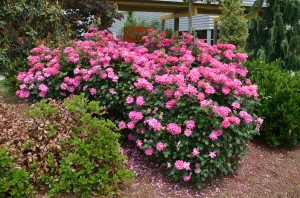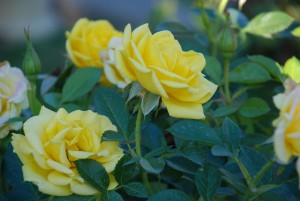A goal of most rose gardeners (rosarians) is to grow them almost maintenance free. The improved shrub roses introduced almost two decades ago have brought this too reality. Rose series such as Knockout®, Home Run®, Drift®, OSO Easy®, Carefree® and Meidiland™ are among the best.
No matter the pedigree of the rose, selecting a poor site, doing something wrong, and new disease problems can disappoint your love affair with roses. Providing a good environment makes growing roses a lot more enjoyable:
- Plant in soil with good moisture drainage
- At least 6 hours of sunlight
- Adequate spacing between shrubs to allow good air circulation
- Shelter from high or drying winds
- Little competition from other plants
- Irrigate ground but keep foliage dry (drip, soaker hoses); best time to water is early morning
- Fertilizers: either a water soluble fertilizer (3-4 times in growing season thru early September); or 10-10-10 (in early spring and mid-July); or slow release fertilizer once in early spring.
- Organic fertilizers (as alternative):
- N (nitrogen) -horse manure – yes!; cow manure –no! (full of weed seeds)
- P (phosphorus) – roses crave P, very important; sources: bone meal, rock phosphate
- K (potassium) – improve summer heat tolerance
- Minors- Fe (chelated iron) and Mg (Epsom salts)
- Mulch with 2-3 inch layer of pine needles, bark chips or nuggets around bushes, but not against trunks.
- Keep roses weed-free as weeds compete and also attract harmful bugs and diseases
- Prune roses in late winter or spring when dormant or starting to bud out
- Prune in summer to remove disease wood, particularly rose rosette or other virus problems



 Posted in
Posted in 
